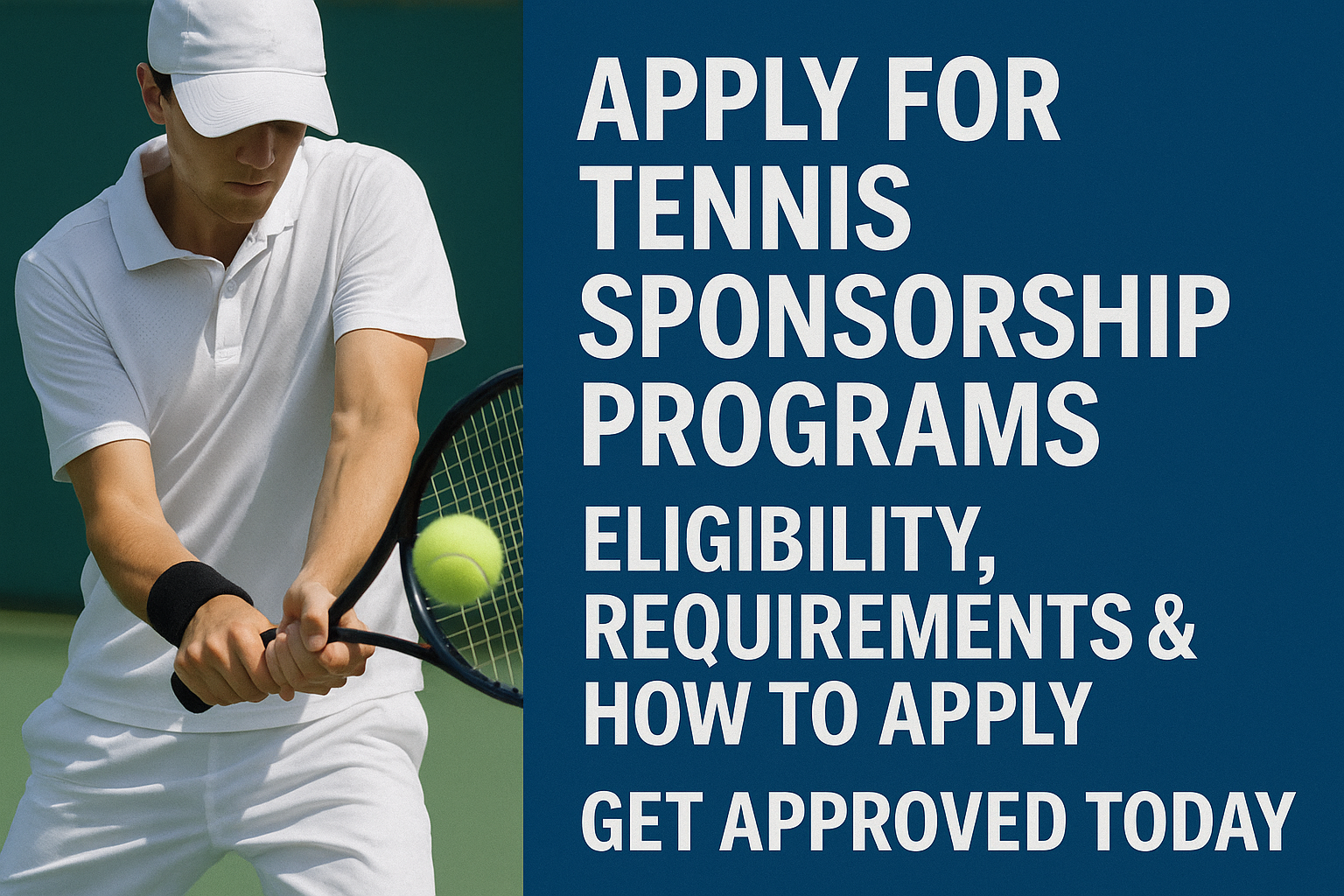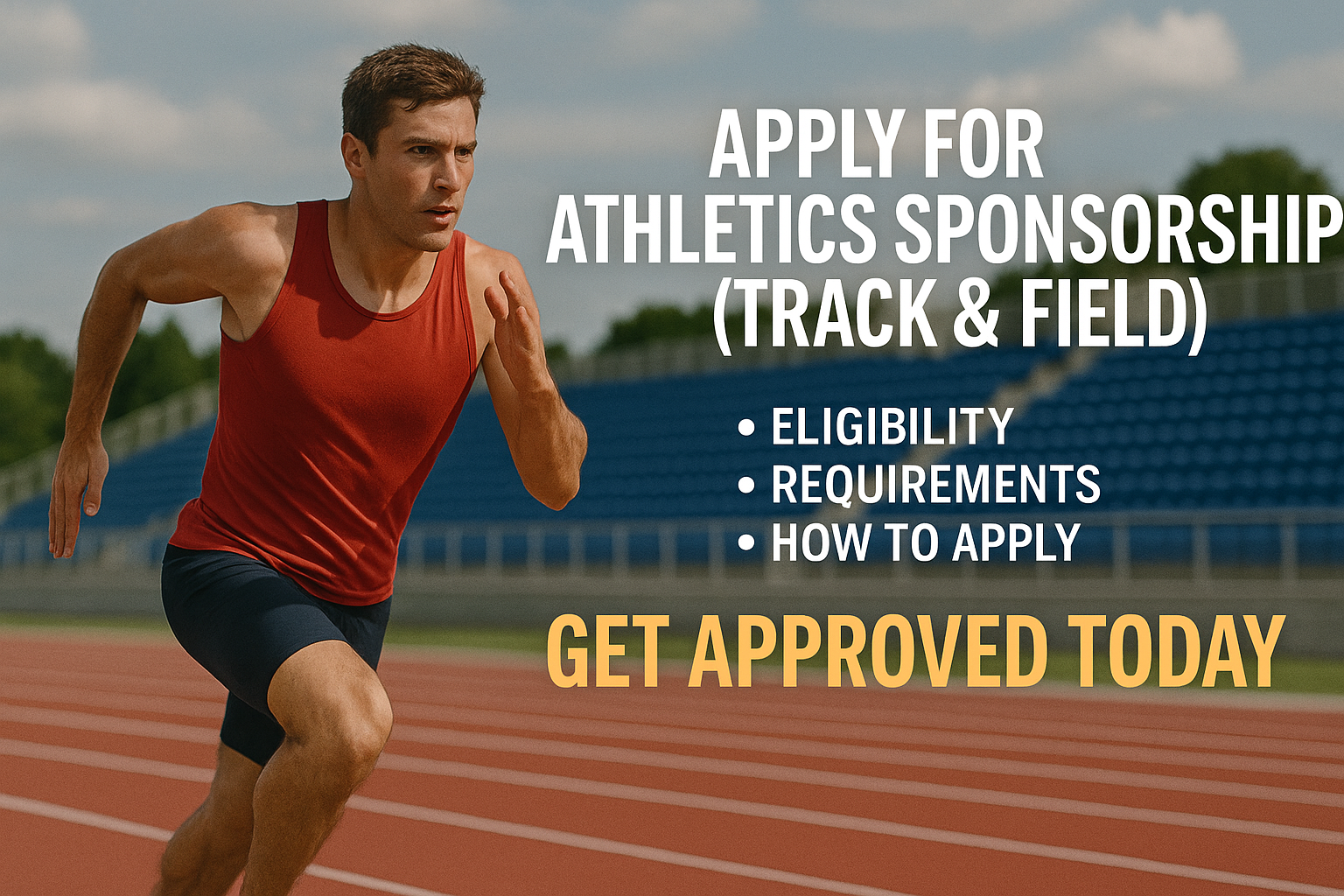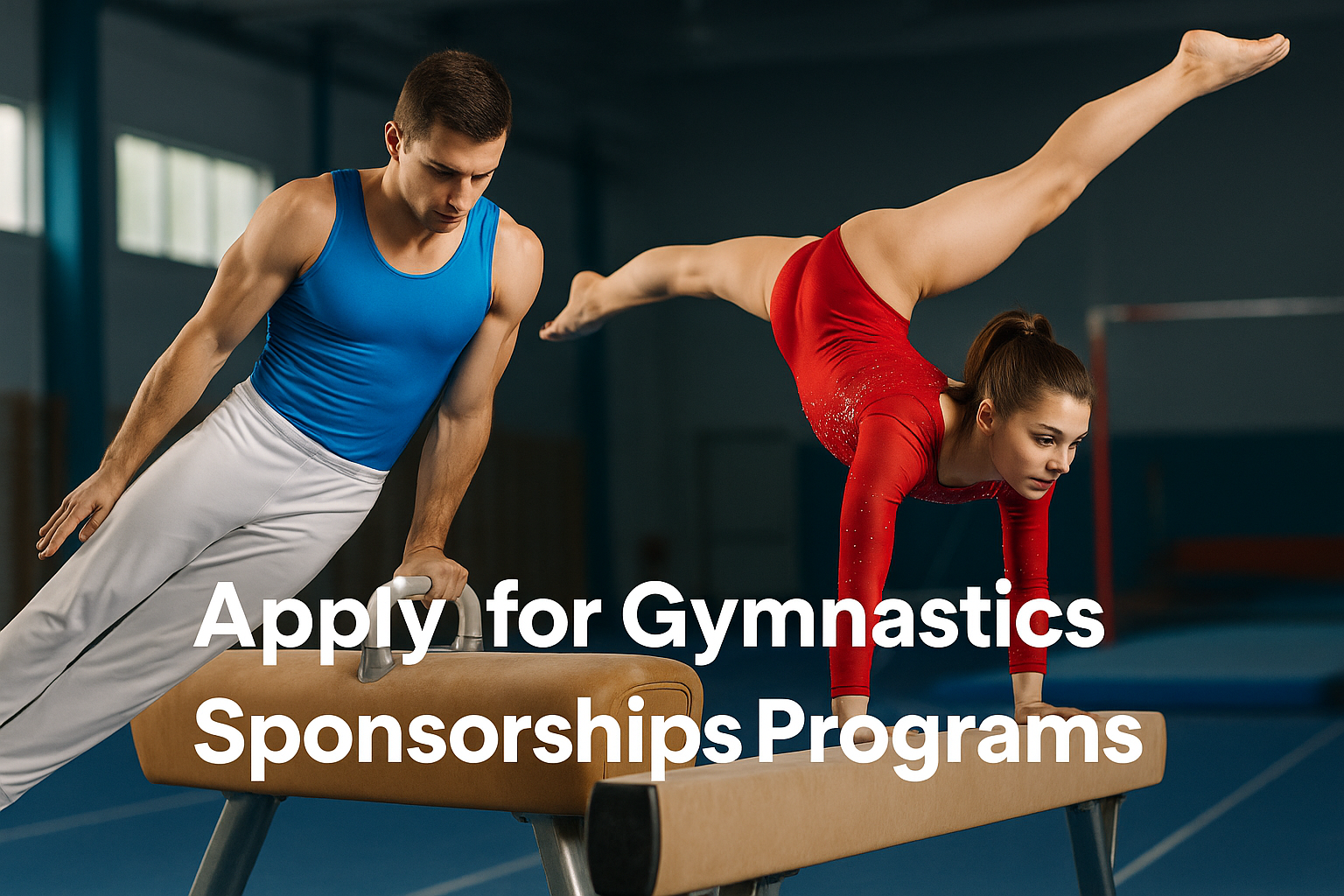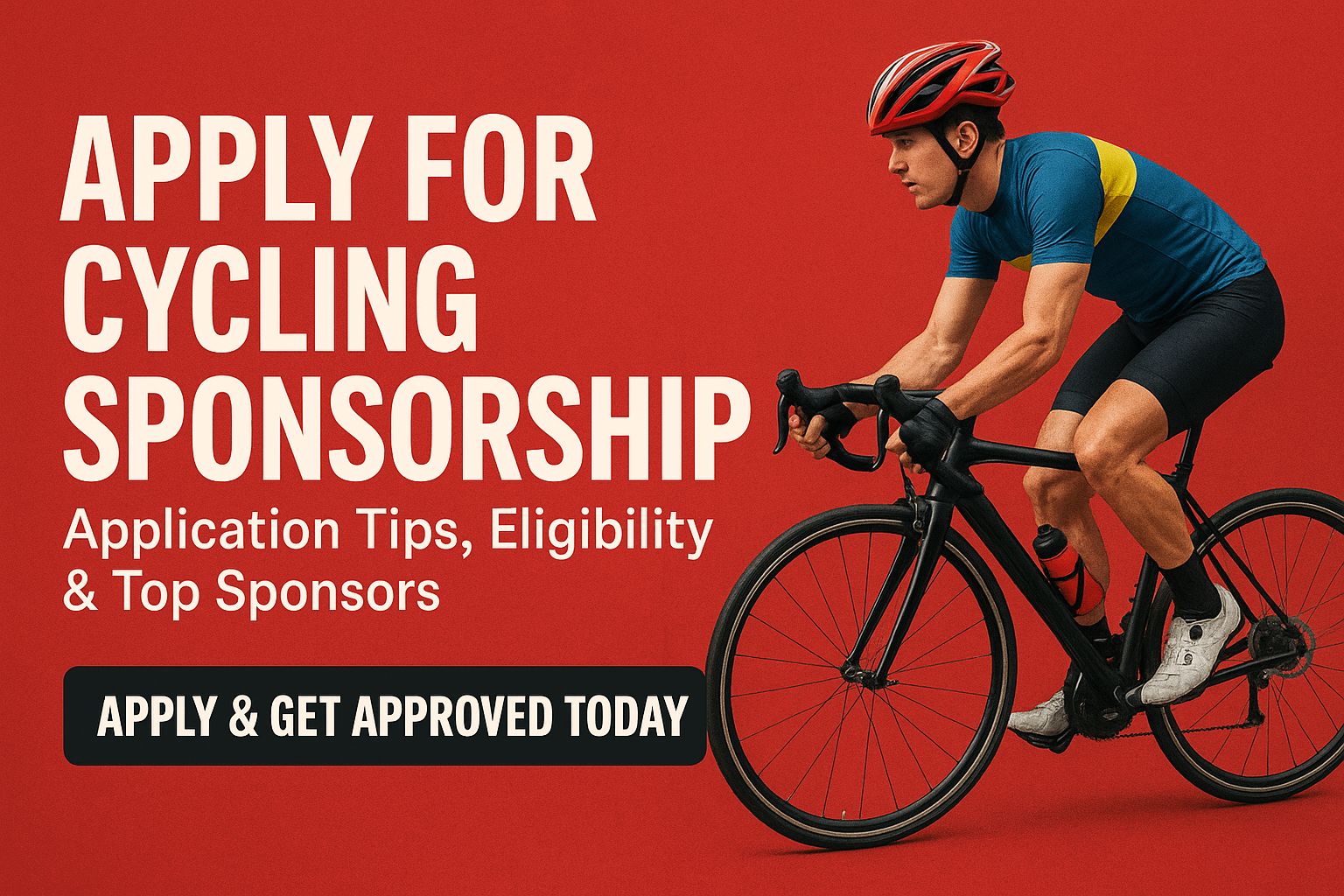For any aspiring tennis player, breaking through the competitive landscape isn’t just about talent, it’s also about opportunity, exposure, and the right support system. Whether you’re a junior on the rise or an adult trying to climb the rankings, Tennis Sponsorship Programs can play a crucial role in your journey. These programs offer much more than financial backing; they’re a gateway to better gear, professional networks, and often, global visibility.
Tennis, unlike some team sports, places a heavy financial burden on individuals. Tournament entry fees, travel expenses, coaching, and high-quality equipment can quickly add up. This is where sponsorships step in. They not only alleviate these costs but also connect players with brands that can elevate their image and provide vital resources. From racquets and shoes to international tournament access, the right sponsor can help you level up your game both on and off the court.
But it’s not just about securing free products or money. Tennis Sponsorship Programs also represent a form of recognition. When a company chooses to back you, it’s a vote of confidence in your potential, character, and performance. Brands are increasingly selective with whom they partner. They want athletes who embody their values, show promise, and engage well with fans and the community. That’s why getting sponsored is as much about personal branding and presence as it is about backhands and forehands.
In recent years, the tennis sponsorship landscape has expanded significantly. With the rise of social media and digital platforms, even players without Grand Slam experience can attract brand attention. You don’t necessarily need to be a top 100 player in the world to get noticed. Companies are now tapping into the influence of micro-athletes, particularly those who have strong local followings or compelling personal stories. This has opened the door for many athletes who previously thought sponsorships were out of reach.
This blog post is designed to walk you through everything you need to know about applying for Tennis Sponsorship Programs. From understanding who qualifies, to what top companies are looking for, to how you can structure your application this guide will break it down step by step. Whether you’re starting from scratch or looking to level up your current sponsorship deals, this is the roadmap to help you get there.
Eligibility
Before diving into application forms and brand emails, it’s essential to first determine whether you’re eligible for a Tennis Sponsorship Program. Sponsorships vary depending on the company and level of the player, but there are a few general criteria most brands use to assess eligibility. Meeting these benchmarks doesn’t guarantee sponsorship, but they significantly increase your chances of getting noticed and seriously considered.
First and foremost, player performance is a key eligibility factor. Brands typically want to align with athletes who are actively competing and achieving measurable success. This doesn’t mean you need to have a Grand Slam title under your belt, but participating in USTA, ITF, ATP, or WTA events and performing well can boost your attractiveness to potential sponsors. Rankings, tournament wins, and consistency over time all paint a picture of a player who is serious about their career.
Another major factor is age and stage of development. Many Tennis Sponsorship Programs are tailored to junior players, especially those showing early potential. These “development sponsorships” often start with partial support free racquets, discounted gear, or entry-level endorsement deals and can grow into more significant contracts as the player progresses. However, there are also programs for collegiate athletes, semi-pros, and late bloomers who demonstrate both talent and a strong work ethic. So, no matter your age, there’s likely a program that fits your profile if you’re committed to growth.
Beyond performance, character and professionalism play a big role in eligibility. Brands want ambassadors, not just athletes. This means sponsors are looking for players who are disciplined, respectful, and team-oriented. A strong attitude on and off the court can sometimes outweigh a single match result. Sponsors are especially drawn to athletes who exhibit leadership qualities, support their communities, or show resilience in the face of setbacks.
Perhaps surprisingly, your social media presence is now an eligibility factor for many companies. Sponsors want visibility, and athletes with active, engaging profiles offer exactly that. If you regularly post training clips, match highlights, behind-the-scenes content, and engage with your followers in a positive way, brands are more likely to see you as a marketing asset. Even if your follower count isn’t huge, consistent and authentic engagement can carry significant weight.
Lastly, location and representation may influence eligibility. Some sponsorships are region-specific, especially for companies looking to break into new markets or support grassroots development in certain countries. In other cases, having a coach, agent, or academy affiliation can also make a difference. These professionals often have direct connections with brands and can vouch for your dedication and potential. If you’re part of a reputable tennis program or academy, that backing can serve as a form of pre-vetting for many sponsors.
Top 10 Companies That Sponsor Tennis Players
In the world of professional and amateur tennis, having the right sponsorship can be a game-changer—both figuratively and literally. While there are dozens of companies that offer support through Tennis Sponsorship Programs, some brands have built a reputation for backing athletes consistently and generously. These companies not only offer financial support and gear, but also credibility. Being associated with one of these top sponsors can elevate a player’s reputation and visibility almost overnight.
1. Nike
Nike is arguably the most recognized name in tennis sponsorship. Known for sponsoring tennis legends like Roger Federer (formerly), Rafael Nadal, and Serena Williams, Nike has deep roots in the sport. Their Tennis Sponsorship Programs range from elite-level endorsements to grassroots development programs for juniors. Nike often looks for athletes who combine talent with a strong personal brand. They prefer individuals who reflect their values—performance, perseverance, and boldness. While getting sponsored by Nike is highly competitive, they often scout players through performance academies, national rankings, and online presence.
2. Adidas
Adidas is another global powerhouse in the tennis world. They have sponsored stars like Alexander Zverev, Dominic Thiem, and Garbiñe Muguruza. Adidas takes a more progressive approach to their sponsorship strategy, often targeting up-and-coming players early in their careers. Their Tennis Sponsorship Programs also extend to college athletes and high-ranking juniors. Adidas values creativity, energy, and resilience. Applicants who align with these themes—on the court and in personal branding—have a higher chance of catching their attention.
3. Wilson
Wilson is best known for its tennis racquets, and many pros swear by the brand—including Stefanos Tsitsipas and Simona Halep. The company is not just a gear supplier; they offer extensive support to players through racquet sponsorships, equipment deals, and long-term athlete partnerships. Wilson’s Tennis Sponsorship Programs target players who are consistent performers, especially those with strong regional or national tournament results. Their junior sponsorship pathway is well-organized and often begins with partial support, leading to full sponsorships as players rise through the ranks.
4. Babolat
Babolat is a favorite among juniors and competitive amateur players. The brand is known for its player-first approach, offering flexible sponsorship options for those who show promise at the grassroots level. Players like Rafael Nadal have helped elevate Babolat’s profile, but the company is deeply invested in emerging talent. Their Tennis Sponsorship Programs usually start with racquet and string packages and evolve into full endorsements based on performance and growth. Babolat values technical play, dedication, and early development, making it a great starting point for younger players.
5. Head
Head has long been associated with some of the sport’s biggest names, including Novak Djokovic and Coco Gauff. This brand is a strong contender when it comes to high-performance gear and sponsorship opportunities. Head’s sponsorships are particularly popular in Europe but have expanded globally. Their Tennis Sponsorship Programs emphasize athleticism, marketability, and tournament exposure. Head also has a strong relationship with tennis academies and often partners with coaches to identify sponsorship candidates. Their support often includes racquets, apparel, and travel incentives for elite juniors.
6. Yonex
Yonex may have a quieter presence than Nike or Adidas, but they are one of the most respected sponsors in tennis. Known for their technologically advanced racquets and footwear, Yonex supports players like Naomi Osaka and Nick Kyrgios. Their Tennis Sponsorship Programs are ideal for technically skilled players who are willing to serve as product ambassadors. Yonex frequently sponsors players at all levels from juniors to professionals—and takes pride in nurturing talent through product education and global exposure.
7. Tecnifibre
Tecnifibre, a French brand, has gained strong traction among competitive junior and challenger-level players. While it may not be as globally recognized as some other brands, its high-quality products and personalized support make it a favorite among serious athletes. Tecnifibre’s Tennis Sponsorship Programs focus on player development, especially in the European and North American circuits. They are known for offering support early in a player’s career, providing racquets, strings, and accessories while fostering long-term relationships based on growth and loyalty.
8. Asics
Best known for their high-performance tennis shoes, Asics is a rising force in tennis sponsorship. While they focus more on footwear than full apparel deals, their athlete support is impressive. Asics sponsors players like Novak Djokovic (for shoes) and rising junior stars worldwide. Their Tennis Sponsorship Programs are usually aimed at athletes who already have a gear sponsor but need top-tier shoes for performance. Players with strong movement and footwork often appeal to Asics, and they prioritize athletes who provide feedback on product innovation.
9. Lacoste
Lacoste combines tennis heritage with contemporary style. Founded by tennis great René Lacoste, the brand continues to support the sport at various levels. Sponsoring Daniil Medvedev and other top players, Lacoste seeks out individuals who embody both elegance and competitiveness. Their Tennis Sponsorship Programs are selective but valuable, often focusing on full apparel deals, marketing opportunities, and international visibility. Lacoste sponsorships are ideal for athletes with strong on-court presence and off-court charisma.
10. Dunlop
Dunlop is a respected name in the world of tennis balls and racquets. The company sponsors players such as Jack Draper and Miomir Kecmanović, and is heavily involved in junior and regional tennis development. Dunlop’s Tennis Sponsorship Programs are accessible and often tailored to up-and-coming players looking for their first major deal. They provide racquet packages, string deals, and ball sponsorships for tournaments. Dunlop has a reputation for being approachable, making them a good fit for players looking to break into the sponsorship world.
Requirements for Tennis Sponsorship Programs
Understanding the requirements for Tennis Sponsorship Programs is critical before you start submitting applications. Sponsorship is a two-way street. While companies offer valuable support, they also expect something in return—whether it’s exposure, performance, or representation. That’s why it’s important to build a complete, compelling package that makes you stand out from the crowd. In this section, we’ll break down the key elements most brands look for in potential sponsorship candidates.
1. Strong Performance Record
Performance is the backbone of any successful tennis sponsorship application. Brands want to see that you’re actively competing and doing well in tournaments. This doesn’t mean you need to be a pro or have a world ranking, but participating in sanctioned events like USTA, ITF Juniors, or national championships is a strong plus. A consistent tournament history, wins over ranked players, or significant improvement over time can demonstrate your growth potential. Many sponsors also look at player rankings both regional and national especially for juniors and college athletes. Be sure to include recent tournament results and your current ranking (if applicable) in your application.
Also, it’s not just about winning. Sponsors respect players who demonstrate sportsmanship, play with heart, and show resilience in tough matches. If you’ve had close matches against top players or made deep runs in tough tournaments, include those details. A narrative of growth and determination is often more attractive than a simple win-loss record.
2. A Professional Player Profile or Résumé
One of the most overlooked parts of applying to Tennis Sponsorship Programs is the player résumé. This document serves as your introduction, it’s your tennis CV. A professional-looking profile should include basic personal details (age, hometown, coach), ranking history, tournament highlights, training schedule, and short-term and long-term goals. Think of it as your personal pitch to the brand. Make it clean, concise, and easy to read. You can include a headshot and a few action shots to help the brand put a face to the name.
You might also consider creating a digital version of your profile something you can send via email or link to through your social media. Some players build small personal websites with video highlights, stats, and contact info. This kind of presentation shows initiative and makes a memorable first impression.
3. Match Footage and Highlight Videos
While your stats tell one side of the story, video footage brings it all to life. Brands want to see you in action how you move, compete, and conduct yourself on court. A short highlight reel (2–4 minutes) is often more effective than a full match. Include shots that demonstrate variety: serve, forehand, backhand, volleys, movement, and footwork. If possible, include footage from matches you won against higher-ranked opponents or from prestigious tournaments.
Make sure the video is clear, steady, and professionally edited. You don’t need high-end production, but avoid shaky or poorly lit videos. Add your name, ranking, and a short intro at the beginning of the video. You can upload it to YouTube or Vimeo and share the link in your application. Good video content can often be the deciding factor in a brand’s decision to sponsor you.
4. Social Media Presence and Engagement
In today’s digital age, social media isn’t just a bonus, it’s a requirement for many Tennis Sponsorship Programs. Brands are looking for athletes who can help promote their products and values to a wider audience. Even if you’re not a celebrity or influencer, having an active and positive online presence makes a big difference. Sponsors look for athletes who post regularly, engage with followers, and share their training, match results, or behind-the-scenes content.
Platforms like Instagram, TikTok, and YouTube are especially effective for building a tennis brand. Focus on authenticity. Show your personality, training journey, challenges, and victories. Being real and relatable builds trust and community something brands value deeply. Also, be aware of your digital footprint. Inappropriate posts or controversial behavior online can hurt your chances of landing a deal.
5. Endorsements and Recommendations
Another powerful requirement that can boost your application is a written endorsement or reference. This can come from your coach, tournament director, or academy head. These testimonials carry weight because they offer an external perspective on your work ethic, attitude, and character. A glowing letter of recommendation can sometimes be the tipping point in a competitive application process.
In your request for a letter, ask the recommender to focus on specific examples how you overcame adversity, showed leadership, or demonstrated consistent improvement. A strong endorsement confirms that you’re not just a good player, but a good representative of the brand. Some companies even require these references as part of the formal application process.
Application Process for Tennis Sponsorship Programs
Applying for Tennis Sponsorship Programs can feel intimidating at first, but with the right preparation and strategy, the process becomes much more manageable—and even exciting. Think of it as a professional job application, where your talent, image, and potential are your strongest selling points. Brands aren’t just investing in athletes—they’re investing in people who represent their values and vision. In this section, we’ll walk you through a detailed, step-by-step guide to help you approach the application process with confidence.
1. Research and Shortlist Target Sponsors
The first step in the sponsorship application journey is identifying the right companies for you. Not every sponsor fits every player. Some brands focus on juniors, while others look for collegiate or professional players. Some specialize in racquets, others in apparel or footwear. Start by researching companies that align with your playing style, level, and values. Look into who they currently sponsor, what type of support they provide (full vs. partial sponsorship), and their application process if it’s publicly available.
Make a shortlist of 5 to 10 brands that you feel a strong connection with. Study their marketing content, mission statements, and the kinds of athletes they promote. Do they value grit and underdog stories? Do they focus on luxury, performance, or youth development? Tailoring your application to fit each brand’s identity will significantly increase your chances of success.
2. Prepare a Complete Sponsorship Package
Once you’ve identified your target brands, the next step is building a sponsorship package. This includes all the materials you’ll submit or present to the company. Your package should include:
- A polished player résumé (as discussed in the previous section),
- A highlight or match video link,
- A brief personal statement or cover letter,
- Social media handles and stats (engagement rate, follower count, etc.),
- Endorsements or letters of recommendation.
Keep your presentation professional and clean. If possible, combine your documents into a single PDF, and make sure all links (like videos or social profiles) are active and easy to access. Don’t forget to brand your materials with your name and contact info on every page—this ensures nothing gets lost or confused.
3. Find the Right Contact Channels
One of the trickier parts of applying for Tennis Sponsorship Programs is figuring out how to submit your application. Some brands have dedicated athlete sponsorship pages on their websites with application forms. Others may require direct outreach through email. If you can’t find a public-facing form, try reaching out to:
- The company’s marketing department,
- Regional brand reps (especially for companies like Wilson, Babolat, or Dunlop),
- Player development coordinators,
- Tennis coaches or academy contacts who may have an inside connection.
LinkedIn and Instagram can also be useful platforms for finding the right people to contact. When reaching out, keep your message short, respectful, and professional. Introduce yourself, express genuine interest in the brand, and attach or link your sponsorship package. Personalize your outreach avoid sending generic, copy-paste emails.
4. Customize Each Application
One of the biggest mistakes players make is sending the same generic email to every sponsor. Brands can tell when they’re receiving a “mass blast.” Take the time to personalize each application. Mention why you’re interested in that specific brand, how their values align with yours, and how you plan to represent them both on and off the court. If you admire their current athletes or use their products already, say so. Authenticity builds connection.
In your cover letter or email, clearly outline what you’re asking for—gear, financial support, tournament funding, etc.—and explain what you can offer in return (social promotion, product reviews, content creation, brand visibility at events). Treat it like a partnership, not a favor.
5. Follow Up Professionally
After submitting your application, give it a couple of weeks before sending a polite follow-up. Sometimes emails get buried, and a gentle reminder can bring your application back to the top of the inbox. Your follow-up message should be brief and courteous:
“Hi [Name], I hope you’re doing well. I just wanted to follow up on my sponsorship application submitted on [date]. I remain very interested in the opportunity to represent [Brand] and would be happy to provide any additional information or updates. Thank you again for your time and consideration.”
Keep in mind that brands receive hundreds of sponsorship requests, and not hearing back immediately doesn’t always mean rejection. If you’re turned down, ask for feedback. You may learn what to improve, or even get considered again in the future. Rejections can become stepping stones if handled with professionalism and positivity.
ALSO READ: [Apply for Swimming Sponsorship Programs]
Conclusion
Securing a spot in a Tennis Sponsorship Program can feel like unlocking a major achievement in your tennis journey—and in many ways, it is. It validates your hard work, puts you in touch with powerful industry connections, and provides practical support that can ease financial and logistical burdens. But more than anything, it opens doors: to better gear, larger tournaments, mentorship, and opportunities you might not have been able to access otherwise.
As we’ve covered in this guide, the path to sponsorship is not reserved only for the top-ranked pros or the kids with agents. It’s open to passionate, committed players who know how to present themselves well, maintain a solid record of performance, and show brands that they are worth investing in. Whether you’re a nationally ranked junior, a hardworking college athlete, or a promising late bloomer, there’s likely a Tennis Sponsorship Program that fits your level and goals.
What sets successful applicants apart isn’t just their backhand technique or win-loss record, it’s how they tell their story. Brands want to be part of something meaningful, whether that’s an underdog story, a rising star’s climb, or a player who brings positivity and visibility to the tennis community. So be sure to communicate not just your achievements, but your journey, your passion, and how you’ll proudly represent the sponsor on and off the court.
Another key takeaway is that this process requires patience, persistence, and professionalism. You might not get a response right away, and that’s okay. The tennis world is competitive, and brands are strategic with who they choose to support. But if you continue developing your game, refining your presentation, and expanding your personal brand, sponsorship opportunities will come.
So what’s next? If you haven’t already, start compiling your player résumé, building your highlight reel, and polishing your online presence. Research brands that align with your personality and career goals. Reach out with confidence, follow up with professionalism, and don’t be afraid to ask for feedback if things don’t work out on the first try. Sponsorship is not just a destination, it’s part of the journey.
And remember: sponsorships are more than free gear or funding. They’re partnerships. When you land a sponsor, you’re not just gaining support you’re becoming an ambassador. So treat every brand interaction with the same focus and respect you bring to the court. If you can do that, you’ll be well on your way to turning your tennis dreams into reality one sponsorship at a time. OFFICIAL LINK
FAQs
FAQ 1: Can beginner or recreational tennis players apply for sponsorships?
Absolutely though the approach and expectations are a little different. Many people assume that only elite-level players can land a spot in a Tennis Sponsorship Program, but that’s not entirely true. While top brands often target competitive juniors, college athletes, or pros, there’s a growing trend toward sponsoring influential recreational players and local tennis ambassadors as well.
If you’re a beginner or club-level player with a strong presence in your local community or online brands might still want to work with you. This is especially true if you regularly post tennis-related content on platforms like Instagram, TikTok, or YouTube. Social media influencers, content creators, and teaching pros are sometimes offered gear discounts, affiliate partnerships, or part-time brand ambassador roles as a form of entry-level sponsorship.
To stand out, show that you’re passionate, consistent, and engaged with your audience. Highlight your love for the sport, post high-quality content, and start building relationships with local reps or regional managers. Even a sponsorship that offers discounted equipment or free demo products can open doors and build credibility for future opportunities.
So yes, whether you’re just starting out or competing weekly at your local club, sponsorships are not out of reach. The key is to position yourself as someone who adds value, either through community engagement or digital influence.
FAQ 2: How long does it take to hear back from a sponsorship application?
The timeline for hearing back from a Tennis Sponsorship Program application can vary widely depending on the brand, time of year, and how you submitted your materials. In general, you can expect to wait anywhere from 2 to 8 weeks. Some companies process applications seasonally particularly around the beginning of the tournament calendar year or when launching new product lines so delays during busy periods are common.
It’s also important to note that some brands receive hundreds of applications every month, especially from juniors and college athletes. If you’re applying to a major company like Nike or Adidas, your application may go through multiple hands before someone gets back to you. Smaller or niche brands like Tecnifibre or Dunlop might respond faster, especially if you’re contacting a regional rep directly.
The best approach is to follow up politely after 2–3 weeks. Keep your message brief and professional, expressing continued interest and asking if any additional information is needed. Avoid sending multiple follow-ups too close together, as it may come across as pushy.
And don’t be discouraged if you don’t hear back at all unfortunately, not all companies respond to every applicant. That’s why applying to multiple brands and customizing each application is essential. Treat it as a numbers game with quality, not desperation. Every application is a learning experience, and each one gets you closer to landing that perfect partnership.
FAQ 3: What if I don’t have a national ranking can I still get sponsored?
Yes, you can still get sponsored even if you don’t have a national or international ranking. While rankings are a strong metric for performance, they aren’t the only criteria that brands consider in their Tennis Sponsorship Programs. Many companies are shifting toward a more well-rounded view of athletes, especially with the rise of social media and content marketing.
If you’re a strong regional player, winning local or sectional tournaments, or even competing in adult leagues with standout results, you still have a chance. Brands often look for consistency, growth potential, and most importantly marketability. If you have a compelling story, a unique style of play, or an engaging personality that comes across well online or in your community, you’re already valuable to them in ways beyond rankings.
For example, a highly followed junior player who shares training routines, reviews gear, or teaches beginners online could be more influential than a player ranked 800 nationally who doesn’t engage with fans or promote their sponsors.
It’s all about how you present your strengths. In your sponsorship application, highlight your dedication to the sport, your community involvement, and any creative efforts you’ve made to contribute to the tennis space. Attach testimonials from coaches, include quality video content, and showcase your social influence if applicable. Not every sponsor is looking for the next Federer many are simply looking for the right fit.
FAQ 4: Are there any costs or hidden commitments in tennis sponsorship deals?
That’s a smart question, and the answer is, it depends on the type of sponsorship. Most reputable Tennis Sponsorship Programs do not ask you to pay to be sponsored. However, depending on the level of the deal, there may be expectations or commitments you’ll need to fulfill, and it’s important to understand these upfront before accepting.
At the entry-level, “partial sponsorships” may offer discounted products instead of free ones. For example, a racquet brand might give you 50% off gear in exchange for promoting their products and tagging them in social posts. This is quite common and generally considered a fair exchange, especially for developing players.
In higher-level deals, sponsors may require you to wear their apparel during matches, use only their products, attend brand events, or share regular content online. These terms will usually be spelled out in a contract or agreement. Some full sponsorships also include performance-based clauses, like maintaining a certain ranking or attending specific tournaments. Failing to meet these requirements could result in your sponsorship being reduced or terminated.
Always read the fine print before agreeing to any terms. Don’t hesitate to ask questions or request clarity on expectations. A sponsorship is a professional relationship, and it’s perfectly acceptable to approach it with the same diligence you would a job offer. Transparency is key, and most brands appreciate athletes who want to do things right.
FAQ 5: How can I stand out from other tennis players applying for the same sponsorship?
Standing out in a competitive pool of applicants for a Tennis Sponsorship Program is all about showcasing what makes you unique. While everyone may have similar goals play better, compete more, win titles your story, attitude, and presentation style are what really separate you from the rest.
Start with your personal narrative. What challenges have you overcome? What drives you? Sponsors connect with real people, not just stats. Share your journey—maybe you picked up tennis late, came back from an injury, or are the first from your community to pursue the sport seriously. A compelling story helps brands connect emotionally.
Next, show professionalism in your presentation. Make sure your player résumé looks clean and organized. Use high-quality images and polished video footage. Even the way you write your email or organize your social media profile says a lot about your attention to detail and maturity.
Also, engage with brands before applying. Tag them in your training posts, use their products (if you like them), and comment on their content. This puts you on their radar. When they see your application come through, you’re not a stranger you’re already familiar and supportive.
Lastly, don’t be afraid to let your personality shine. Sponsors want relatable, energetic ambassadors not robots. Whether it’s through humor, honesty, or hustle, be memorable for the right reasons. After all, when it comes to getting noticed in a sea of athletes, being authentically you is the biggest advantage of all.





